Android System SafetyCore: A New Layer of Privacy-Oriented User Protection
On November 7, 2024, Google introduced a pivotal System update for Android 9 and later versions, unveiling a novel service named Android System SafetyCore. While most updates involved standard security patches, SafetyCore's introduction marked a distinct shift. In a developer note, Google described it as an "Android system component that provides privacy-preserving on-device user protection infrastructure for apps." Beyond this, Google offered little explanation, leaving both users and developers scratching their heads.
Unveiling SafetyCore's Functionality
Initial information about SafetyCore surfaced in Google's announcement of enhanced security features for Google Messages, albeit without directly naming SafetyCore. The announcement introduced "Sensitive Content Warnings," a feature designed to automatically blur images potentially containing nudity, requiring user interaction to reveal them, and offering guidance and options to navigate sensitive material. This protective measure extends also to outbound content, prompting users before sending such images. Importantly, Google reassured users that the feature operates independently of Google's servers, ensuring no violation of privacy through image analysis.
It later became evident that SafetyCore's capabilities surpassed mere detection of nude imagery. Google explained that SafetyCore employs built-in machine-learning algorithms to identify and filter a variety of sensitive content. The system provides an infrastructure for on-device secure classification, responsive only when apps request its functionality through enabled options. Users maintain control over this feature, reinforcing privacy-first principles.
User Concerns and Privacy Implications
Reaction from users has been a mixed bag, shadowed largely by privacy concerns, particularly regarding the silent installation process on devices without explicit user consent. Unlike traditional apps, SafetyCore lacks a visible icon, only discoverable under "Settings > Apps > Show system processes," compounding user concerns over transparency.
Critics argue that despite Google's reassurances, the unobtrusive installation gives rise to apprehensions about potential surveillance, even though data remain on the device, not shared externally. Discussions on platforms like Reddit highlight fears of SafetyCore acting like a surreptitious entity, spurring discontent over transparency and autonomy.
Managing and Removing SafetyCore
For users uncomfortable with SafetyCore's presence, deactivating or removing it requires navigating to "Settings > Apps & Notifications > See all apps," tapping the menu to show system apps, locating SafetyCore, and opting to uninstall or disable it. Note that uninstalling may be impossible on some devices, offering only the option to disable. There have also been reports of the service reinstalling post-system updates, demanding repeated action from users.
Comparative Analysis: Google and Apple's Privacy Strategies
SafetyCore's initial friction contrasts Apple's approach with its own Communication Safety features on iPhones. Apple's transparency and granting users choice over such features spotlight a user-centric model that many users advocate for. Apples' upfront communication regarding such functionalities fosters a sense of control and trust, a direction Google might benefit from emulating.
Google's Response to Criticism
In response to coverage highlighting these privacy debates, a Google representative clarified, "By default, Google System services automatically update devices with security, bug fixes, and new features, all delivered through isolated packages. This approach maintains user privacy, adhering to the principle of least privilege, ensuring permissions aren't intermingled across functionalities."
Ultimately, SafetyCore exemplifies a technological push toward enhanced user safety on mobile devices. Nevertheless, the conversation accentuates an ongoing tension between innovation and user autonomy, underscoring the need for greater transparency and control as cornerstones in tech development.











 浙公网安备
33010002000092号
浙公网安备
33010002000092号 浙B2-20120091-4
浙B2-20120091-4